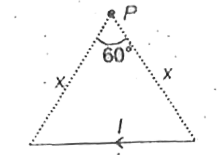A vertical straight conductor carries a current vertically upwards. A point P lies to the east of it at a small distance and another point Q lies to the west at the same distance. The magnetic field at P is_______.
The correct Answer is:greater orless than at Q depending upon the strength of the current
Similar Questions
Knowledge Check
A straight vertical conductor carries a current. At a point 5cm due north of it, the magnetic induction is founded to be 20μT due east. The magnetic induction at a point 10cm east of its will be
A5μT northB10μT northC5μT southD10μT southA straight wire of finite length carrying current I subtends an angle of 60∘ at point P as shown. The magnetic field at P is
 Aμ0I2√3πxBμ0I2πxC√3μ0I2πxDμ0I3√3πx
Aμ0I2√3πxBμ0I2πxC√3μ0I2πxDμ0I3√3πxDue to a straight vertical current carrying conductor, a null point occurred at P on east of the conductor. The net magnetic induction at a point 'Q' which is at same distance on north of the conductor is
A0B√2BHCBHD√2BH
A point P lies on x-axis and another point Q lies on y-axis.
Write the ordinate of the point P.
View SolutionA point P lies on x-axis and another point Q lies on y-axis.
Write the abscissa of the point Q.
View SolutionA long straight vertical conductor carries a current of 8A in the upward direction. What the magnitude of the resultant magnetic induction at a point in the horizonatal plane at a distance of 4 cm from the conductor towards South? (The horizontal compo-nent of earth's magnetic induction =4×10−5T)
View SolutionA current-carrying straight wire is held in exactly vertical position. If the current passes through this wire in the vertically upward direction, what is the direction of magnetic field produced by it ? Name the rule used to find out the direction of magnetic field.
View SolutionA point P lies on the axis of a flat coil carrying a current. The magnetic moment of the coil is μ. The distance of P from the coil is d, which is large compared to the radius of the coil. The magnetic field at P has magnitude
View Solution
